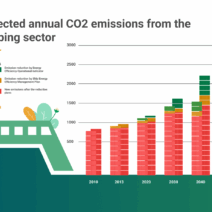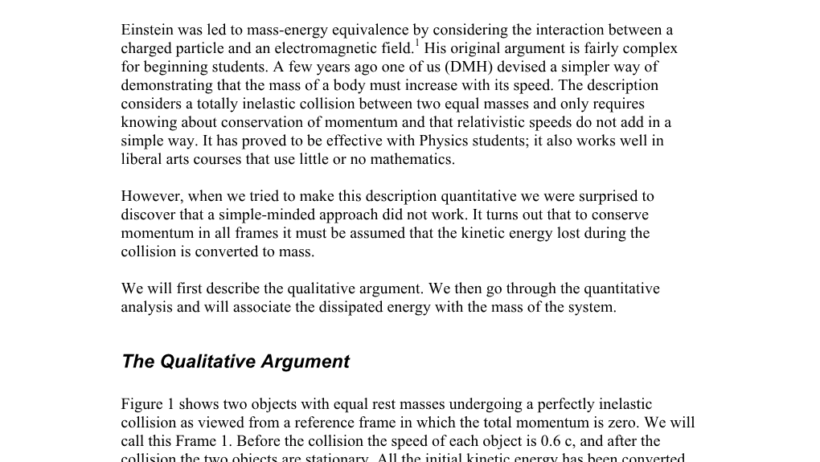When pondering the laws of physics, one may wonder: is energy conserved in the tantalizing realm of relativistic inelastic collisions? This seemingly esoteric question opens the door to a fascinating interplay between energy, momentum, and the mysteries of relativity. In this exploration, we will unravel the intricacies of relativistic collisions and the fundamental principles governing energy conservation.
The principle of conservation of energy is often heralded as one of the cornerstones of physics. It stipulates that energy cannot be created or destroyed, only transformed from one form to another. In classical mechanics, this principle holds firm in elastic collisions, where kinetic energy is conserved alongside momentum. However, as we delve into the relativistic domain, where particles move at velocities approaching the speed of light, the scenario becomes markedly more complex.
Inelastic collisions, by their nature, involve a loss of kinetic energy. When two objects collide inelastically, they may stick together or deform, resulting in some kinetic energy being converted into other forms of energy, such as thermal energy or sound. This raises a pertinent question: if kinetic energy is not conserved, does this signal a violation of the broader conservation of energy principle in relativistic contexts?
To address this inquiry, we must first consider the framework of special relativity, as articulated by Albert Einstein. In this model, energy is not merely a manifestation of kinetic energy; it comprises several components that contribute to a system’s total energy. The most pivotal expression of this concept is encapsulated in Einstein’s famous equation, (E=mc^2), which illustrates the profound interrelationship between mass and energy. This equation implies that an increase in kinetic energy, resulting from relativistic speeds, corresponds to a corresponding increase in the system’s relativistic mass.
In inelastic collisions, while kinetic energy may be redistributed or transformed, the total energy—including rest energy—remains conserved. Thus, while individual kinetic energies might fluctuate, the aggregate energy within an isolated system persists. This reconciliation emerges from the realization that energy can transition among various forms, sustaining the conservation principle when viewed holistically.
The pivotal distinction in relativistic collisions lies in understanding how momentum and energy interact. Momentum, defined as the product of an object’s mass and velocity, also adheres to the conservation law. In a closed system undergoing a relativistic inelastic collision, both momentum and energy conservation can coexist, albeit under nuanced interpretations. While the kinetic energy before and after the collision may indeed differ, the total energy, when accounting for rest mass energy, remains invariant.
Consequently, the analysis of a relativistic inelastic collision can be visualized through a thought experiment: envision two particles, each racing toward each other at significant fractions of the speed of light. Upon collision, they coalesce into a single entity, reshaping their kinetic forms into other energy manifestations. This transformation could yield warmth through friction or even electromagnetic radiation as the particles oscillate post-impact. The energy is redistributed rather than obliterated—a pivotal distinction in the conservation narrative.
Diving deeper into examples, consider cosmic phenomena such as high-energy collisions in particle accelerators, or even celestial events like neutron star mergers. When particles collide at relativistic speeds, the resultant energy and momentum exchanges illuminate the complexities of energy transformation. Detecting new particles, transformations, and the energies released during such collisions continually reinforces the notion that while kinetic energy may exhibit apparent loss in isolated evaluations, total energy remains preserved in the grand tapestry of physical interactions.
It’s also intriguing to note that these relativistic considerations bring about practical implications for conservation efforts. For instance, understanding energy transformations in high-speed collisions can inform engineering designs in safety technologies, optimize fuel consumption in high-speed travel, and enhance energy recovery processes. By grasping the nuances of energy conservation and transformation, technologists and engineers can innovate more effectively within the bounds of sustainability.
Furthermore, this discourse aligns with the critical modern advocacy for energy conservation in our ecological pursuits. As energy exchanges in various forms underscore the importance of efficiency, the principles gleaned from relativistic physics may inform renewable energy technologies—harnessing the potential of kinetic energy through wind turbines or transforming solar radiation into usable power. Thus, the interplay of relativistic mechanics not only propels advanced theoretical physics but also resonates deeply with environmentalism.
In conclusion, the question of whether energy is conserved in relativistic inelastic collisions invites a broader contemplation of energy in all its forms. While kinetic energy may not remain constant in such collisions, the total energy—comprising rest mass energy and other contributions—remains invariant, affirming the overarching principle of energy conservation. This nuanced understanding enriches our appreciation for the fundamental laws that govern not only the cosmos but also the intricate balance we strive to maintain in our own environment. By recognizing the dynamic marvels of energy transformation, we engage not just in academic exploration, but in the vital quest for sustainability and conservation of our planet’s resources.








